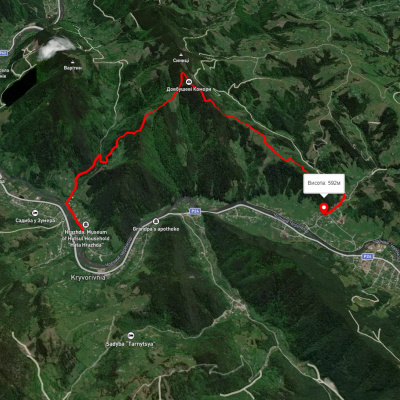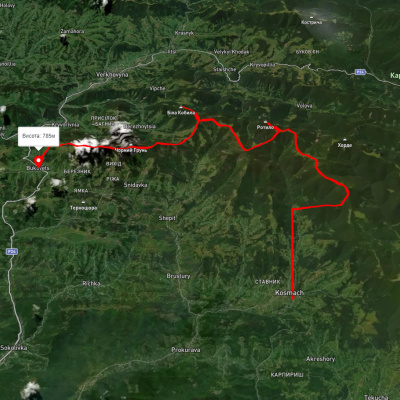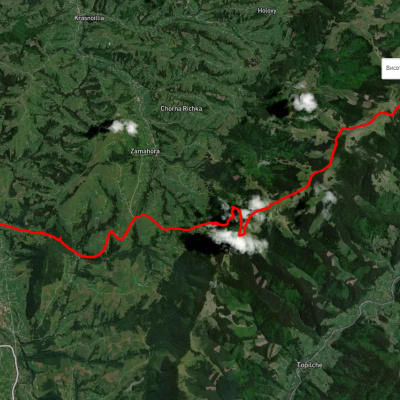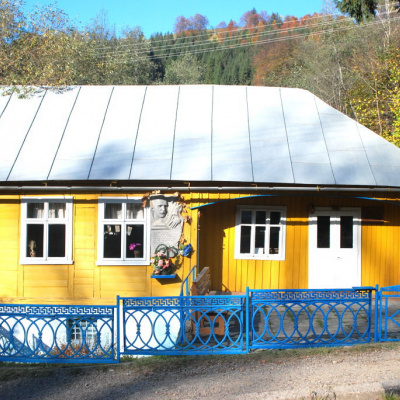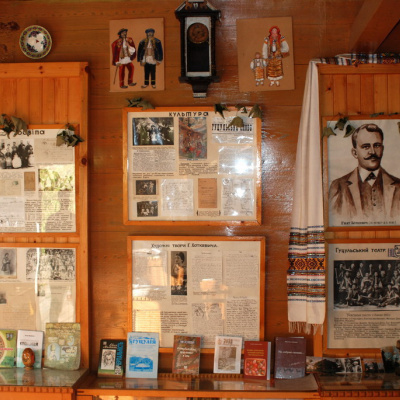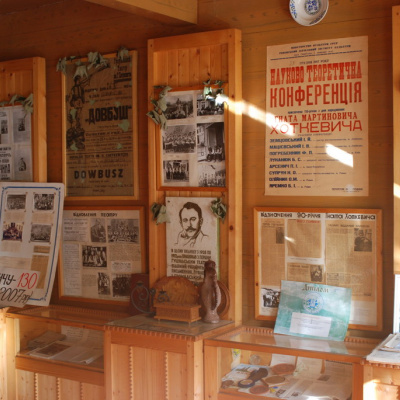Folk Museum of Hutsul Theater of H. M. Hotkevych
The mountain village of Krasnoillia has attracted the attention of many writers, ethnographers, and scholars for its beauty. In the early twentieth century, it was visited by: Volodymyr Hnatiuk, Ivan Franko, Mykhailo Kotsiubynskyi, Mykhailo Vakhniuk, Volodymyr Shukhevych, Les Kurbas, Stanislav Vintsenz, Mykhailo Lomatskyi, and many other famous figures.But Krasnoillia, like Hutsulshchyna, owes a special debt to Hnat Khotkevych, a native of Slobozhanshchyna, a writer and playwright who, after the revolutionary events of 1905 in Russia, emigrated to Galicia, to Lviv, and then to Hutsulshchyna, to Kryvorivnia and Krasnoillia.
A small wooden house stands in the center of Krasnoillia village. On the wall is a memorial plaque with an inscription: "In 1908-1912, the famous Ukrainian writer and public figure Hnat Martynovych Khotkevych worked in this house with the first Hutsul theater." The house was built in 1906 at the expense of the village community as a community center with a reading room. In this house, H. Hotkevych created his miracle - the First Hutsul Theater, with which he conquered the theaters of Galicia, Bukovyna, Poland, and Russia.
On the 110th anniversary of the writer's birth, a public museum was opened in the house. In December 2004, the museum was awarded the title of "national". The museum's exposition is housed in a room and a hall with a stage where the first Hutsul theater's performances took place. It consists of the following main sections: "History"; "Life"; "Education and Culture". The exposition of the first room begins with the history of the village. Here we learn about the first written mention in 1661, and according to Petro Sirezhuk's research in 1649.
The showcases contain metrical church books, lists of members of the "Sobriety" society, photographs of the participants of the Hutsul uprising of 1920, and household items. Another section tells about the first school, founded in 1827, documents about schools in the Kosiv district, and about the first teacher Mykhailo Morovyk. The next section is devoted to Hotkevych's connection with the Hutsul region. While staying here for 6 years, he fell in love with this land, its people, and the Hutsul dialect, and created series of works about the nature of the Hutsul region: "Mountain Watercolors", about the life of Hutsuls "Hutsul Patterns" and other masterpieces.
In the center of the exhibition is a portrait of H. Khotkevych and photographs of the members of the First Hutsul Theater. The first performance of the play "Verkhovyntsi" by Polish writer P. Kozheniowski, translated into the Hutsul dialect by the writer under the title "Antin Revizorchuk", took place in the reading room of the village of Krasnoillia, and the second in Zhabia in 1910. Since then, the drama group was called the Hutsul Theater.
The next exposition is dedicated to the actors of the first Hutsul theater: there are photocopies of letters and memoirs of the theater members; press reviews of the theater's performances and tours led by the director, political emigrant, former actor of the St. Petersburg Imperial Theater O. Remez. Part of the exposition tells about the theater's Hutsul evenings; it also presents musical pieces for bandura played by H. Hotkevych.
These expositions tell about the second revival of the Hutsul Theater in 1930 under the leadership of Vasyl Kostyniuk. The stands include photographs of the Khotkevych family, the theater's participation in the first Chervona Ruta festival in 1989. There is also an exhibition dedicated to the 120th anniversary of Les Kurbas, who played in the Hutsul theater in 1912. Other stands tell about the celebration of H. Hotkevych's 125th birthday in the village, the regional theater festival in Verkhovyna, and a tour to Kharkiv. The exhibition continues with press coverage and stands and posters about the theater's tour to Przemyśl in 2005.
In 2007, a theater festival dedicated to the 130th anniversary of H. Hotkevych was organized. The museum also houses a photo of the second generation of the theater's actors. In 1987, on the occasion of the 110th anniversary, a new plaque with a bas-relief of Khotkevych was installed on the building of the Prosvita reading room. In the hall, the exhibition begins with photographs on stands about the third generation of the modern Hutsul theater, revived in 1988 under the direction of Maria Didushko and Volodymyr Sinitovych. There are also posters of the theater's performances in 1988 at the M. Zankovetska Theater in Lviv, with H. Hotkevych's play "Hutsul Year" at the evening dedicated to the 50th anniversary of H. Hotkevych's tragic death. The modern Hutsul Theater is composed mainly of grandchildren and great-grandchildren of former actors from the first and second generations of the theater, who popularize the theatrical heritage of H. Hotkevych.
Weekends: Monday, Saturday
Opening hours: from 10:00 to 18:15; Sunday: from 10:00 to 17:00.
Lunch: from 14:00 to 15:00.
Accommodation around Folk Museum of Hutsul Theater of H. M. Hotkevych:
Nearby hiking trails near Folk Museum of Hutsul Theater of H. M. Hotkevych:
Які маршрути проходять повз Folk Museum of Hutsul Theater of H. M. Hotkevych?
Пропонуємо пройти такі туристичні (пішохідні) маршрути через/біля Folk Museum of Hutsul Theater of H. M. Hotkevych: На Довбушеві Комори, с. Космач, через г. Ротило, г. Грегіт, г. Біла Кобила до с.Буковець, смт. Верховина – хр. Кринта-Скупова, смт. Верховина – хр. Кринта-Скупова – смт. Верховина, смт. Верховина – г. Скупова, с. Зелене, через г. Скупова до смт. Верховина
